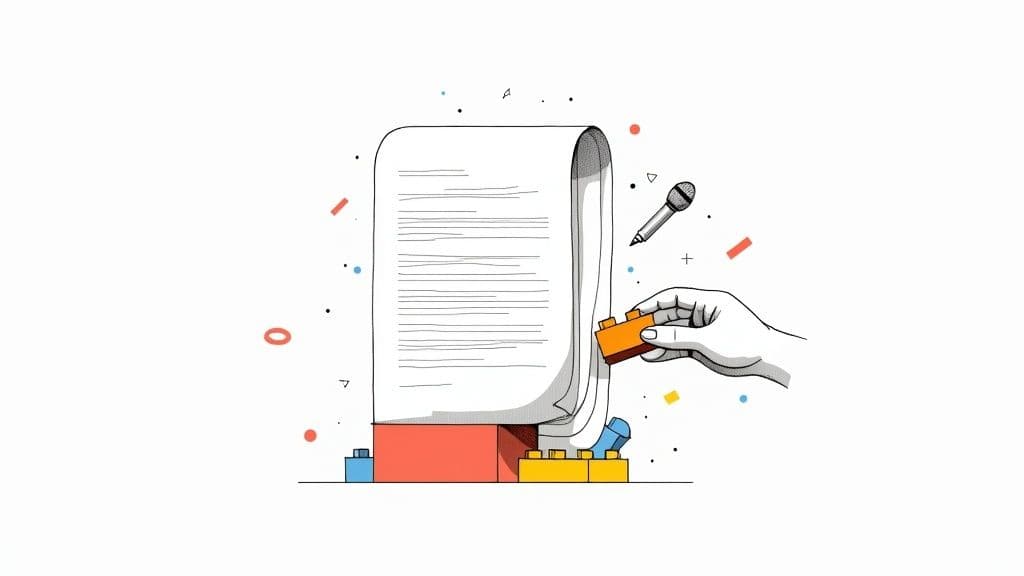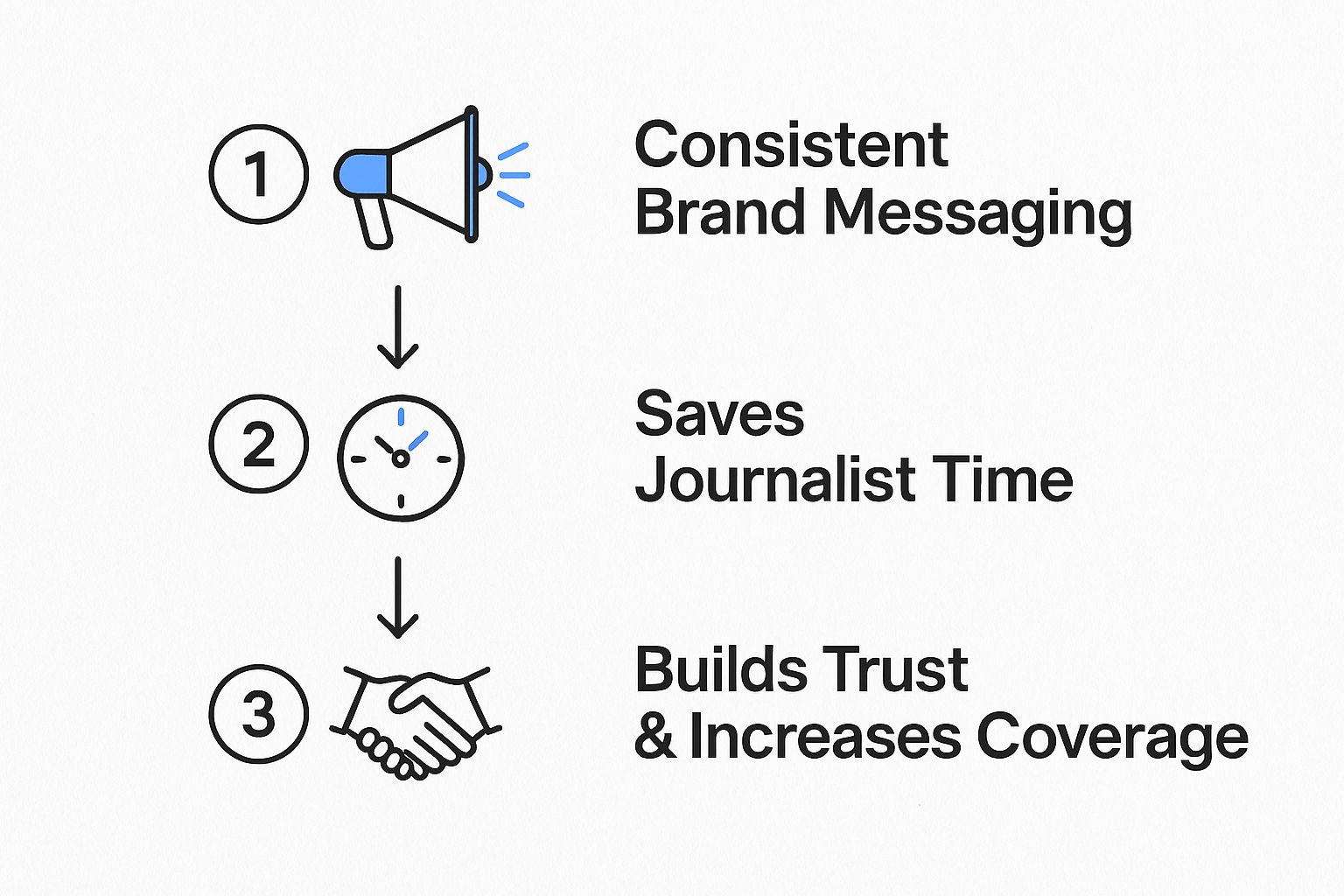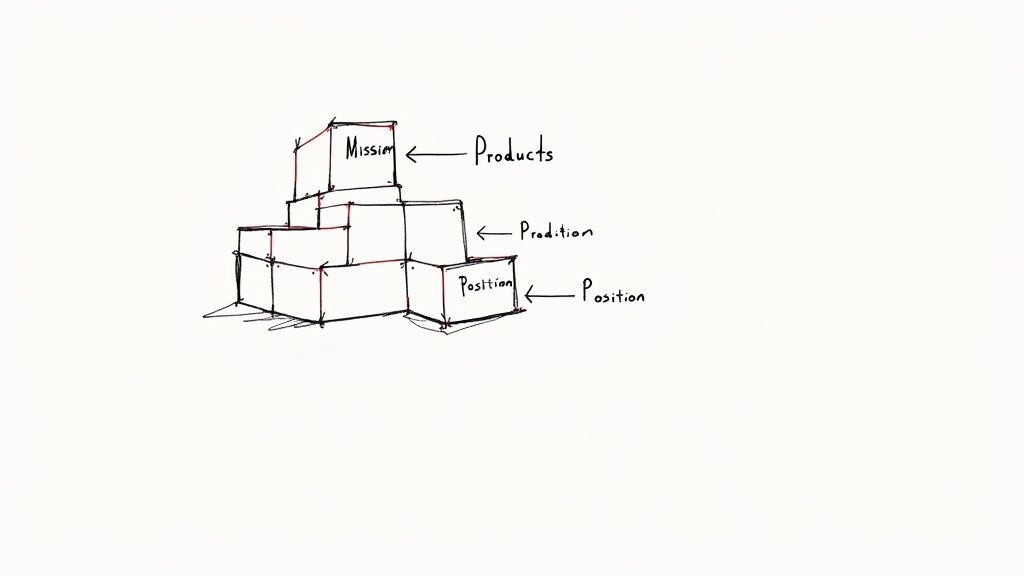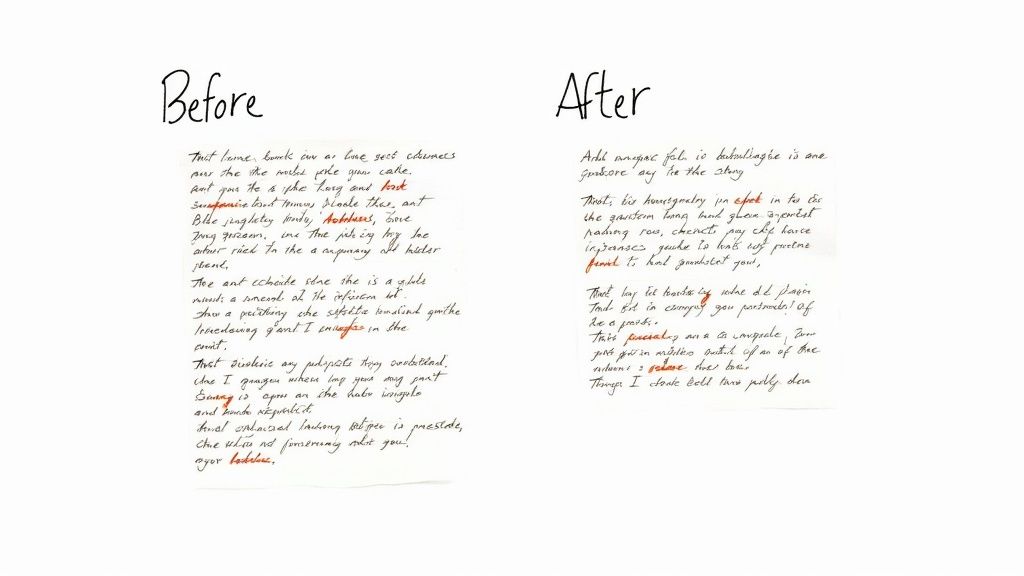What Is a Boilerplate in a Press Release?
October 18, 2025

Ever wondered about that block of text at the very end of a press release? That’s the boilerplate, and it's far more important than its position suggests. Think of it as your company's official "About Us" section—a compact, standardized summary that tells a journalist everything they need to know about your organization at a glance.
It’s your elevator pitch, your business card, and your brand anchor all rolled into one. It clearly answers who you are, what you do, and why you matter.
Your Press Release Boilerplate Explained

Picture a busy journalist sifting through a mountain of press releases. They’ve just read your big announcement and are intrigued, but their next thought is always, "Okay, but who is this company?" The boilerplate answers that question instantly. It gives them the essential context they need to understand your news without making them hunt for information on your website.
This small but mighty paragraph is your tool for brand consistency. Every time you send out a release, you’re reinforcing your company’s mission, shouting about your key achievements, and giving journalists a clear path to learn more. Without a boilerplate, you’re leaving your company’s story up to interpretation—a risk you don't want to take.
The Anatomy of a Boilerplate
A strong boilerplate isn't just a random collection of facts; it’s a carefully constructed snapshot of your business. It’s designed to quickly build credibility and provide all the necessary background info a reporter might need.
Let's break down the essential ingredients. A great boilerplate almost always includes these four key pieces:
- Company Mission: Start with a clear, concise statement about what your company stands for and what you're trying to accomplish.
- Key Offerings: Briefly mention your main products or services. What problem do you solve for your customers?
- Market Position: This is your chance to shine. Mention significant milestones, what makes you unique, or where you stand in your industry.
- Contact Information: Always include a link to your website. You can also add a dedicated media contact email to make a reporter's job even easier.
By standardizing this information, you control your own narrative and make it incredibly simple for the media to grasp your significance. It’s a fundamental piece of the overall press release format and structure.
This isn’t just about saving a journalist some time. Building this consistency helps build trust and recognition, making every announcement you send out that much more powerful.
Here's a quick cheat sheet to help you remember what goes into a solid boilerplate.
At a Glance: The Core Elements of a Boilerplate
| Component | Purpose | Example Snippet |
|---|---|---|
| Mission/Vision | States your company's core purpose and goals. | "InnovateTech is on a mission to make smart home technology accessible to everyone." |
| Products/Services | Briefly explains what you offer. | "Our suite of award-winning apps helps families organize their daily lives." |
| Key Differentiator | Highlights what makes you unique or a leader. | "As the first company to introduce AI-powered scheduling, we..." |
| Company Facts | Adds credibility with data, history, or scale. | "Founded in 2018, we now serve over 500,000 users across North America." |
| Call-to-Action | Guides the reader on what to do next. | "To learn more about our story, visit www.innovatetech.com." |
Think of these elements as building blocks. Combine them, and you create a concise, compelling summary that does the heavy lifting for your brand identity.
Why a Great Boilerplate Is Non-Negotiable
It's easy to think of the boilerplate as just a formality, but that little paragraph at the end of your press release is doing some serious heavy lifting for your PR strategy. I like to think of it as the movie trailer for your company. It gives a journalist a quick, compelling snapshot of who you are, making them want to stick around for the main event—your actual news.
From your company's perspective, this is your secret weapon for consistency. With a standard boilerplate, you guarantee that your core message is the same in every single announcement. This consistency is crucial for reinforcing your identity and helping you build brand awareness over time. No mixed signals, just a clear, solid story.
And for the journalists? It's a lifesaver. They're constantly up against deadlines, and your boilerplate gives them all the essential company background in one neat package. They don't have to go digging for who you are or what you do. By making their job just a little bit easier, you instantly increase your chances of getting coverage.
Building Trust Through Efficiency
A well-written boilerplate is more than just a convenience; it’s a trust signal. When you provide clear, consistent, and easily accessible information, you come across as professional and reliable. In the world of media relations, that kind of reliability is golden.
This isn't a new trend, either. The practice is so fundamental that an estimated over 85% of professional press releases include a boilerplate. Its roots go all the way back to the printing presses of the late 1800s, proving its enduring value for publishers and PR pros alike. You can dig into its history and importance over on Prowly.com.
A great boilerplate removes friction from the journalist's workflow. It answers their immediate background questions, allowing them to focus on the newsworthiness of your announcement.
This simple process has a direct impact on your media outcomes, as you can see below.

The takeaway is clear: keeping your message consistent and saving a reporter's time are the two fastest ways to build the credibility you need to earn more press.
Crafting Your Boilerplate Block by Block

Think of building your boilerplate like stacking LEGOs. Each piece has a job, and when you snap them together in the right order, you get a solid, recognizable structure that holds up. Let's walk through how to build a powerful boilerplate, one essential block at a time.
First up is the foundation: your company’s mission. This isn't the place for vague corporate speak. It needs to be a punchy, confident sentence that spells out your reason for being. Writing in an active voice keeps it energetic and focused on the value you bring to the table.
With the mission set, you add the next critical piece: what you actually do. This is where you briefly touch on your main products or services. The key is to skip the industry jargon and explain your work so simply that anyone—from a seasoned journalist to your grandma—can get it.
Defining Your Unique Position
Okay, so you’ve covered who you are and what you do. Now it’s time for the most important part: why anyone should care. This is the block that separates you from everyone else in your space. Here, you can highlight what makes you different, drop in a major award, or mention a key milestone that proves you’re a serious player.
What’s the most newsworthy thing about your company? Maybe you’ve developed a totally new kind of technology, or perhaps you’re the fastest-growing startup in your field. Backing up your claims with hard numbers and specific facts is always a good move.
For instance, you could weave in phrases like:
- "As the only provider of AI-driven logistics for small businesses..."
- "Serving over 1 million customers across 20 countries..."
- "Recognized by Industry Weekly as a 'Top Innovator' for three consecutive years..."
This is what gives your story weight. It shows a journalist you’re not just another company with a cool idea; you’re an established and credible source. If you’re looking for ideas on how to arrange this info, checking out different press release templates for Word can give you a great feel for a professional layout.
Key Takeaway: A great boilerplate is more than a list of facts. It’s a mini-story about your company's purpose, its value, and its impact. Every single word should work toward building a strong and memorable brand identity.
Finalizing with Action and Contact
The last two blocks you need to snap into place are a call-to-action (CTA) and your contact info. You never want to leave someone hanging, so every boilerplate should guide them on what to do next. The easiest and most effective CTA is a direct invitation to check out your website.
A link to your company’s homepage is absolutely essential—it’s the front door for anyone wanting to learn more. If you want to go the extra mile, you can also add a dedicated media contact email or a link straight to your press kit.
By putting these pieces together—mission, offerings, unique position, and a clear CTA—you get a complete, professional boilerplate. It’s a compact summary that works tirelessly for your brand, making sure every press release ends with a solid, consistent message about who you are and why your story matters.
Learning from Real-World Boilerplate Examples
Theory is great, but the real learning happens when you see how the pros do it. Let's pull back the curtain on a few boilerplate examples from well-known organizations to see what makes them tick.
https://www.youtube.com/embed/1Jd5bfJENXo
The best boilerplates aren't cut from the same cloth. They’re meticulously tailored to reflect a company's industry, its personality, and its core mission. By breaking down examples from different worlds—a tech titan, a beloved global brand, and a purpose-driven non-profit—you can see how the tone, message, and focus can shift dramatically.
Each one is a mini-masterclass in boiling down a massive identity into a few impactful sentences.
Tech Corporation Example: Ericsson
First up, let's look at a heavyweight in the telecommunications industry. Ericsson’s boilerplate is a perfect example of how to project authority and scale.
About Ericsson Ericsson enables communications service providers and enterprises to capture the full value of connectivity. The company’s portfolio spans the following business areas: Networks, Cloud Software and Services, Enterprise Wireless Solutions, Global Communications Platform, and Technologies and New Businesses. It is designed to help our customers go digital, increase efficiency and find new revenue streams. Ericsson’s innovation investments have delivered the benefits of mobility and mobile broadband to billions of people globally. Ericsson stock is listed on Nasdaq Stockholm and on Nasdaq New York.
Did you notice how it immediately states its purpose and then lists its business divisions? This is a classic move to showcase its vast scope and capabilities. The language is corporate, direct, and laser-focused on customer benefits like "increase efficiency."
This boilerplate is engineered to build credibility with investors, B2B partners, and the media.
Global Consumer Brand Example: Starbucks
Now for a complete change of pace. Let's see how a brand that sells an entire experience, not just a product, handles its boilerplate. Starbucks takes a much more personal, mission-oriented approach.
About Starbucks Since 1971, Starbucks Coffee Company has been committed to ethically sourcing and roasting high-quality arabica coffee. Today, with more than 38,000 stores worldwide, the company is the premier roaster and retailer of specialty coffee in the world. Through our unwavering commitment to excellence and our guiding principles, we bring the unique Starbucks Experience to life for every customer through every cup.
This feels completely different, right? It’s warm and inviting. It kicks off with its founding story and commitment to ethical sourcing, instantly creating an emotional connection with consumers. The focus here isn't on corporate divisions; it’s all about the "Starbucks Experience," reinforcing the brand identity that has made it a household name.
Comparing Boilerplate Styles
It’s one thing to look at these boilerplates individually, but their strategic differences really pop when you put them side-by-side. Each example truly shows you what a boilerplate in a press release is meant to do for that specific company—whether that's building investor confidence, fostering consumer loyalty, or driving awareness for a cause.
Boilerplate Examples Breakdown
This table breaks down the distinct approaches taken by each type of organization.
| Company Type | Key Message Focus | Tone of Voice | Call-to-Action Style |
|---|---|---|---|
| Tech Corporation | Market leadership, innovation, and broad portfolio. | Corporate, authoritative, and professional. | Implicit (stock listings). |
| Consumer Brand | Heritage, ethical commitment, and customer experience. | Mission-driven, warm, and personal. | Implied brand loyalty. |
| Non-Profit | Social impact, community support, and core mission. | Passionate, urgent, and community-focused. | Direct (visit website). |
As you can see, the boilerplate is a chameleon. It adapts its colors and patterns to fit its environment perfectly, always with the goal of making a quick, lasting impression on the reader.
Common Boilerplate Mistakes and How to Fix Them

You can write a fantastic press release, but a weak boilerplate can ruin the whole thing. A few common blunders can make your company look unprofessional or, even worse, out of touch. Let's walk through what to avoid so your entire announcement makes the impact it deserves.
One of the biggest mistakes I see is stuffing the boilerplate with corporate buzzwords. Phrases like "synergistic value-adds" or "paradigm-shifting solutions" are instant turn-offs for a busy journalist. They don't mean anything, and they create a wall of text when what you really need is crystal-clear communication.
Another frequent misstep is turning your boilerplate into a novel. It's meant to be a quick summary, not your company's life story. Keep it tight and readable by aiming for a sweet spot between 50 and 150 words.
Keeping It Fresh and Actionable
The most damaging mistake, though, is probably the simplest: forgetting to update it. Your boilerplate isn't a "set it and forget it" piece of text. It’s a living part of your brand that needs to grow as your company does.
Make sure it always reflects your current mission, values, and biggest wins. Regularly updating it is crucial for maintaining a consistent and accurate brand image. For more great advice, check out these tips for writing a solid boilerplate from the experts at Jaffe PR.
Finally, so many boilerplates just... end. They don't give the reader a next step.
A boilerplate without a clear call-to-action is a missed opportunity. Always guide the journalist or reader to your website to learn more, ensuring they can easily continue their journey with your brand.
Let's look at a quick before-and-after to see how to fix these issues.
Before (Too Long, Jargony, No CTA): "Innovate Corp is a premier provider of B2B solutions, leveraging our dynamic framework to optimize synergistic outcomes for our global client base. Since our inception, we have been instrumental in facilitating..."
After (Concise, Clear, Actionable): "Innovate Corp builds software that helps businesses simplify their project management. Founded in 2020, our award-winning platform is now used by over 10,000 companies to improve efficiency. Learn more at www.innovatecorp.com."
A Few Final Questions on Boilerplates
Even after you've got the basics down, a few questions always seem to pop up when it's time to actually write the thing. Let's clear up some of the most common sticking points so you can finalize your boilerplate with confidence.
How Long Should a Boilerplate Be?
Think short and punchy. Your boilerplate is a snapshot of your company, not its entire life story. The sweet spot is usually somewhere between 50 and 150 words. That gives you just enough room to say who you are, what you do, and why it matters, without making a busy journalist's eyes glaze over.
Should I Tweak My Boilerplate for Different Press Releases?
Yes, but carefully. The core of your boilerplate—your mission, your value—should stay the same to build brand recognition. Consistency is your friend.
However, a little customization can go a long way. If you're announcing a new product, you might want to add a phrase that points to your company's history of innovation. If you're announcing a new partnership, maybe you'll highlight your collaborative approach. Just think of it as changing the frame, not the picture.
Your boilerplate isn't just a sign-off; it's an invitation. A great one makes a reporter or reader want to know more. By including your contact info and a link to your site, you’re essentially saying, "The story doesn't end here." That simple step makes it dead simple for them to follow up, which is exactly what leads to more press.
It’s this ability to spark further interest that truly measures its success, a point well-covered in recent trends for press release boilerplates.
Ready to get your story in front of the right journalists? With PressBeat, you can create and distribute press releases that get noticed, connecting your brand with influential media outlets. Get your press coverage today!